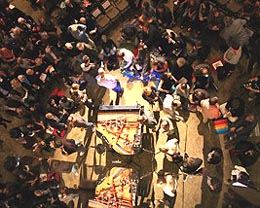On May 1, 2015, Seattle Symphony debuts avant-garde Seattle sound sculptor Trimpin's (b. 1951) site-specific composition "Above, Below, and in Between" at Benaroya Hall. (The symphony's composer-in-residence, Trimpin was born Gerhard Trimpin, but since the 1960s is known by the single moniker.) Before an overflow crowd, conductor Ludovic Morlot (b. 1973) waves his baton at the Microsoft 3-D camera "Kinect," stretching the bounds of his conducting experience. In the Grand Lobby of Benaroya Hall, audience members sit in a semi-circle facing the conductor, as if they were the orchestra. String and horn players fan out above and behind them on the mezzanine. A single soprano vocalist moves among the listeners. The movements of Morlot’s baton activate a prepared piano, a set of concert chimes, and other electro-mechanical instruments instruments positioned among the nine columns of the lobby, so that -- with music emanating from all sides -- the audience is immersed in mind-tingling sounds.
Sculptures in Sound
Since moving to Seattle from his native Germany in 1980, Trimpin has produced a steady flow of hard-to-categorize sound sculptures, often for venues in New York, Europe, and across the United States. He composed music for eccentric instruments that he built of salvaged materials and operated electronically via various kinds of scanners and computer programs. Over the years Trimpin collaborated with dance and theater companies, as well as with other artists at local performance venues including Seattle’s On The Boards and Meany Hall. Trimpin also created site-specific kinetic sound sculpture installations for art museums in the Northwest and abroad.
In the late 1980s, during a stint as resident artist at the Sweelinck Conservatory in Amsterdam, Trimpin met renowned composer Conlon Nancarrow (1912-1997). Trimpin had devised a machine to transpose and preserve the fragile player-piano rolls Nancarrow composed on and finally was able to demonstrate it for the composer and convince him it would work. Their ensuing friendship and performances together brought Trimpin growing acclaim in international experimental music circles. But it wasn’t until Trimpin received a MacArthur Fellowship, the so-called "genius award," in 1997, that more general renown came to Trimpin in his hometown.
In 1999, Microsoft co-founder Paul Allen (1953-2018) commissioned him to design a signature piece for the lobby of the new Experience Music Project. The dramatic "If VI WAS IX," an interactive tower of more than 500 instruments, is programed to play works from the entire history of guitar music, from ballads and flamenco to punk. Then in 2005, to celebrate Trimpin’s 25th year in Seattle, independent curator Beth Sellars organized a two-year appreciation by a constellation of museums and performance venues -- including the Frye Art Museum, Tacoma Art Museum, Henry Art Gallery, Seattle Art Museum, and the Museum of Glass -- showing new and retrospective works. The Kronos Quartet also commissioned a piece.
A Kinetic Ensemble
In 2014, the Seattle Symphony's forward-thinking young music director, Ludovic Morlot, invited Trimpin to be the symphony's composer in residence for three years and create a new work for the symphony.
As usual, Trimpin didn’t just create a musical score. He also designed "a kinetic ensemble" of musical sculptures, which he positioned in specific locations determined by the exact calculated dimensions of the Benaroya Hall Grand Lobby. He placed musicians and instruments up to 30 meters apart, a distance that takes sound almost a tenth of a second to travel. That’s a long delay for audience and musicians, Trimpin said, "But this was essential to explore the time/space continuum implemented in the composition ..." (Trimpin, 3).
A mainstay of the piece was a two-octave "reed horn" Trimpin devised from 24 recycled pump organ reeds hooked up to an electric blower. Concert chimes belonging to the late composer Henry Brant (1913-2008) were positioned throughout the lobby. Trimpin prepared a piano with a special magnetic bowing apparatus that activated the strings without touching them, adding an automatic playing device that controlled the keyboard from a laptop computer.
Perhaps the most challenging role fell to Symphony conductor Ludovic Morlot, who had to conduct the live orchestra members and a wandering vocalist (Jessika Kenney), while at the same time directing the automated instruments, via the Microsoft 3-D camera "Kinect" and a computer screen. With an expression of simultaneous delight and anxiety, he managed to pull it off.
"Above, Below, and In Between" provided a thrilling, total immersion experience for audience and performers. Reviewer Michael Upchurch noted that "The cheers that greeted Trimpin and the performers at the end of the piece were so enthusiastic that, for an encore, Morlot offered a second run through its third movement: a gradually intensifying rumbling piano drone, with [the vocalist] improvising wordless vocals over it. In her second go-round, she hit notes both comical and dramatic, as she thrust her head into the souped-up piano as if to insist that banshee wails could outclass high-tech wizardry any day" (Upchurch, The Seattle Times).

